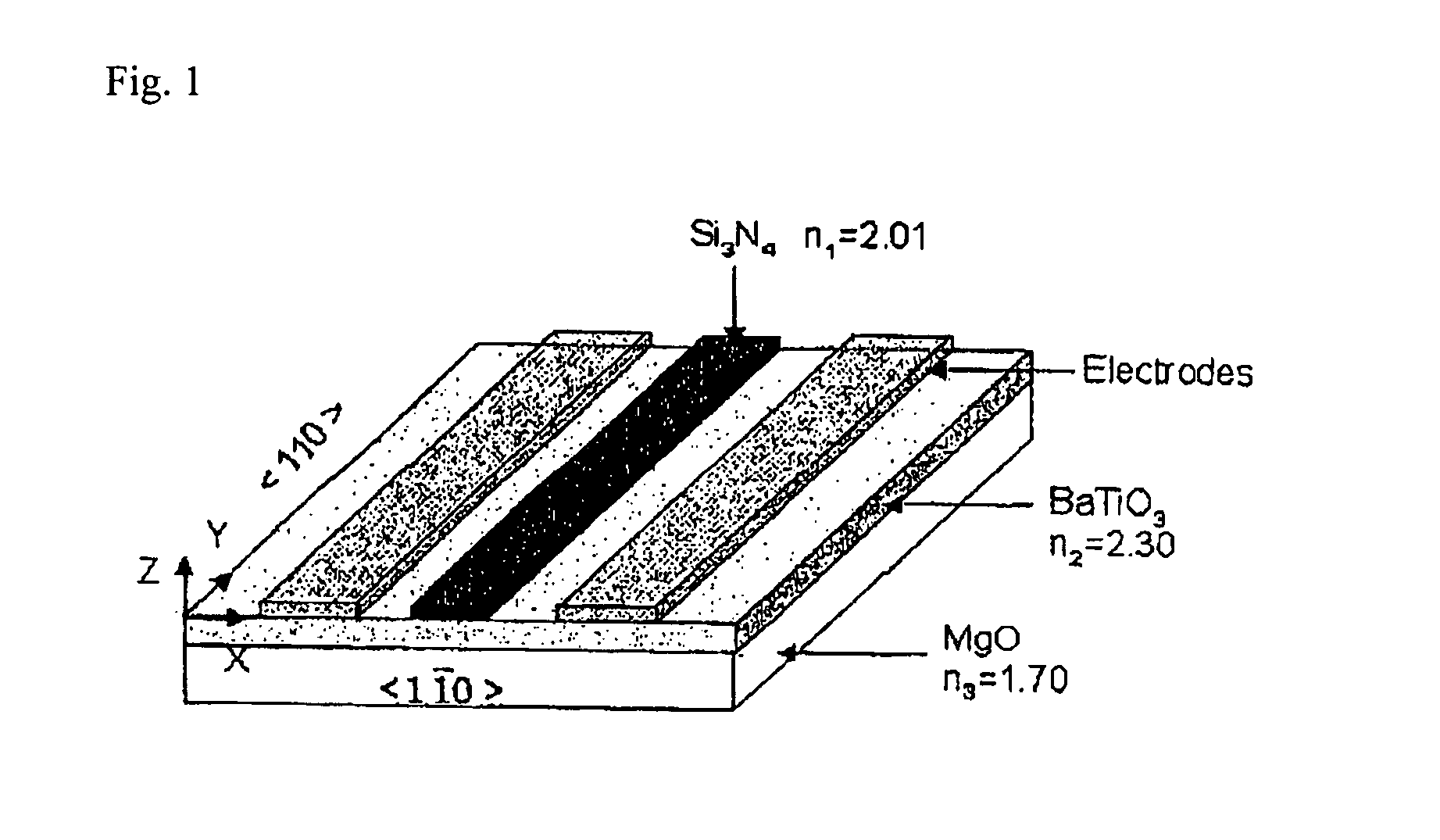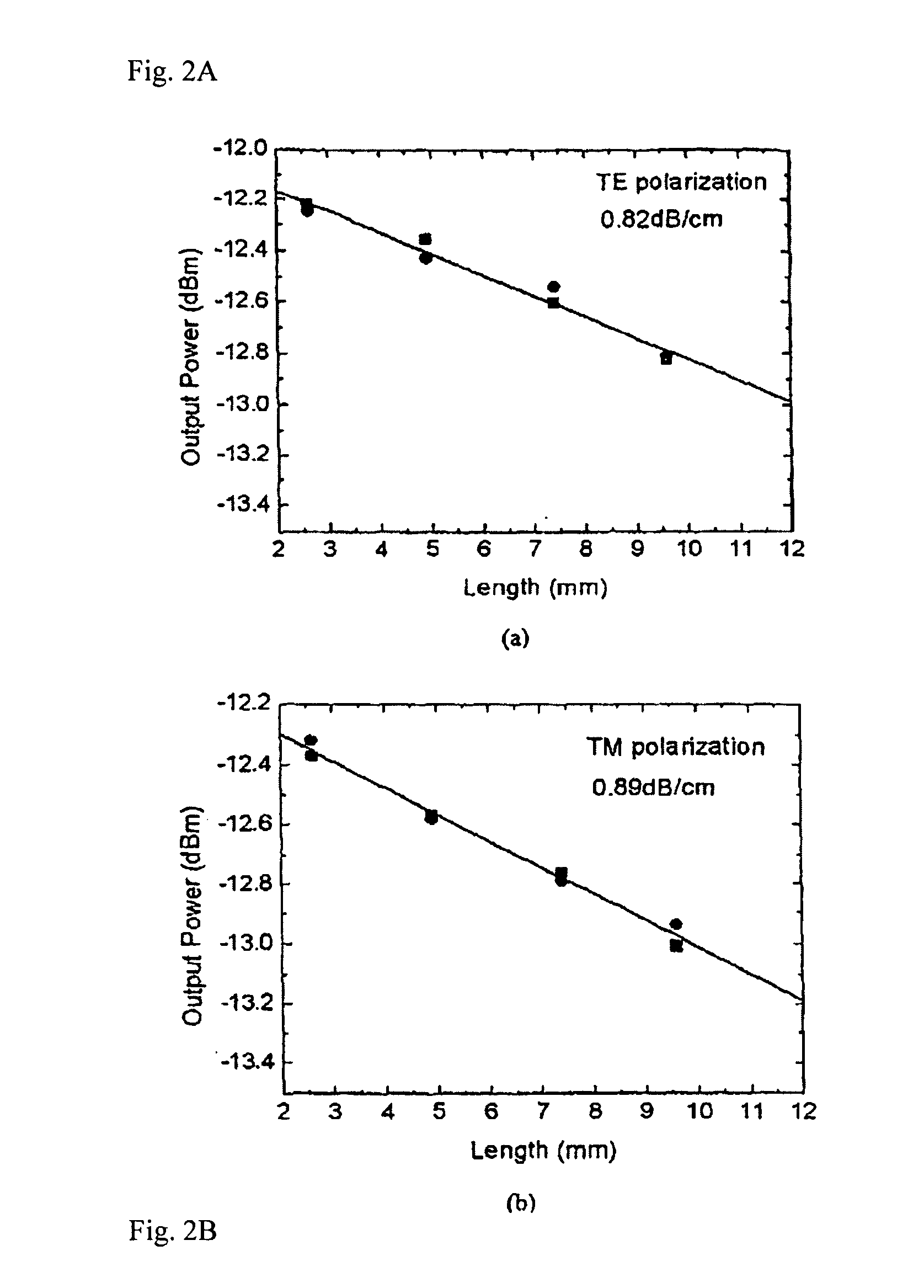BaTiO3 thin film waveguides and related modulator devices
a thin film waveguide and modulator technology, applied in the direction of optical waveguide light guide, optical waveguide, instruments, etc., can solve the problems of large dielectric constant that limits the application of high modulation bandwidth, metal-diffusion and ion-exchange fabrication methods adapted for linbo/sub>materials, and the failure of bulk batio/sub>3 /sub>materials, etc., to achieve low waveguide losses, low driving voltage and low low polarization
- Summary
- Abstract
- Description
- Claims
- Application Information
AI Technical Summary
Benefits of technology
Problems solved by technology
Method used
Image
Examples
example 1
[0049]BaTiO3 thin films were deposited by low pressure MOCVD in a horizontal quartz reactor. The metal-organic precursors used were titanium tetraisopropoxide (TTIP, 99.999% purity) and a fluorinated barium precursor (Ba(hfa)2·PEB), prepared and purified as described in the literature. The oxidant was ultra-high purity oxygen. Argon was used as the carrier gas. Standard deposition conditions used source temperatures of 130° and 35° C. for Ba(hfa)2·PEB and TTIP, respectively. The oxygen flow rate of 100 sccm resulted in a partial pressure of 1.8 Torr, with a system pressure of ˜4 Torr. Carrier gas flow rates were 70 and 18 sccm for the Ba and Ti precursors. The TTIP line employed a 50 sccm dilutant flow between the bubbler and the reactor. The MgO (1 0 0) substrates were boiled in electronic grade acetone and methanol and ultrasonically cleaned prior to use.
example 2
[0050]The two-stage growth process included a low temperature nucleation stage (˜750° C.) and a high temperature growth stage (˜900° C.). After depositing for 5 min at 750° C., the temperature was rapidly ramped (˜2° / s) to high temperature with continuous film growth throughout the ramp process. Typical growth rates were 300–400 nm / h. The thickness of the nucleation layer is estimated at ˜20 nm, based on prism coupling measurements of a thick film grown under the low temperature conditions. Films from about 100 to about 1500 nm thick have been grown using this technique.
example 3
[0051]The phase purity, epitaxy, and crystallinity of the present films were examined using a four-circle X-ray diffractometer with a graphite monochromator and 12 kW rotating anode Cu Kα source. Film thickness and refractive index were measured using a Metricon 2010 prism coupler with a 632.8 nm laser source. A Digital Nanoscope III atomic force microscope (AFM) with Si3N4 tip was used to determine the root mean square (RMS) surface roughness and surface morphology. A Hitachi S4500 scanning electron microscope with cold field emission source was used for high resolution cross-sectional imaging.
[0052]As demonstrated above, low loss, small size, low driving voltage waveguide modulator of this invention can be used as an optical building block for the next generation of ultra-broadband, high-speed fiber-optic Internet networks. Such a modulator can also be a key-enabling element for ultra-wideband optical signal processing applications, including large optical data handling in links o...
PUM
| Property | Measurement | Unit |
|---|---|---|
| thickness | aaaaa | aaaaa |
| half-wave voltage length | aaaaa | aaaaa |
| wavelength | aaaaa | aaaaa |
Abstract
Description
Claims
Application Information
 Login to View More
Login to View More - R&D
- Intellectual Property
- Life Sciences
- Materials
- Tech Scout
- Unparalleled Data Quality
- Higher Quality Content
- 60% Fewer Hallucinations
Browse by: Latest US Patents, China's latest patents, Technical Efficacy Thesaurus, Application Domain, Technology Topic, Popular Technical Reports.
© 2025 PatSnap. All rights reserved.Legal|Privacy policy|Modern Slavery Act Transparency Statement|Sitemap|About US| Contact US: help@patsnap.com



